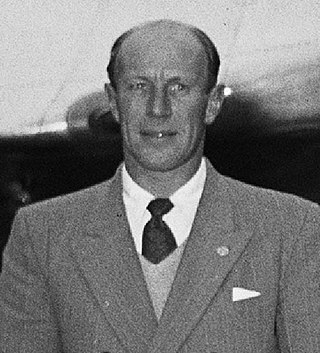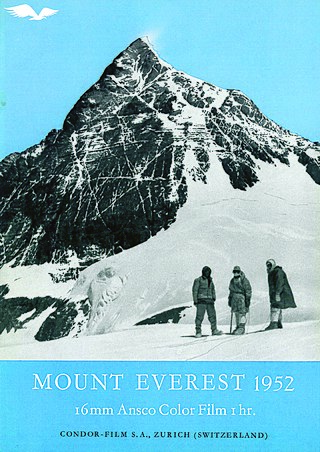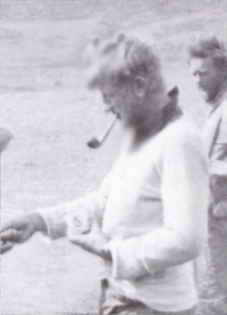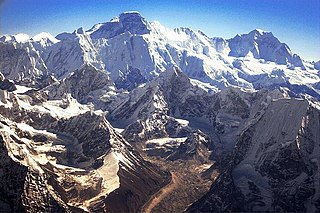Background
After World War II, with Tibet closing its borders and Nepal becoming considerably more open, the reconnaissance of Mount Everest from Nepal had become possible for the first time.
In 1950 a highly informal trek involving Charlie Houston and Bill Tilman reached what was to become Everest Base Camp on the Khumbu Glacier. Although their report about whether the summit could be reached from there was not very encouraging, they thought an attempt might nonetheless be viable. [1]
Topographical knowledge in 1951
By 1951 the location of the South Col was well known – it had been seen from the east in Tibet and photographed from the air – but it had never been possible to view its western side. There remained three main aspects of a route to Everest via the Western Cwm where the difficulties were unknown: the Khumbu Icefall, the climb up to the South Col, and the ascent to the final ridge.
The best evidence about the Icefall was from Tilman and Houston, who were the only people to have seen it close up and who considered it difficult but achievable. The Western Cwm had been glimpsed several times, but it was not clear whether its floor was relatively flat or if it sloped up towards the head of the glacier below the South Col. A pronounced slope might make ascending the valley more awkward but it would reduce the height to be climbed at the head of the valley. Regarding the final ridge, the pair had seen a very steep ridge, quite possibly unclimbable, but they realized that appearances might have been deceptive [note 1] : the ridge observed might have been blocking the view of a true ridge from the South Col to the summit. The 1921 reconnaissance had ascended the Kama valley east of Everest to approach the Kangshung Face. Observing the South Col from that side, they had seen a seemingly easier ridge linking it to the summit. [3] [4]
In early 1951, Everest enthusiast Michael Ward was carefully studying relevant photographs and maps (the Milne-Hink map) in the Royal Geographical Society archives when he happened to find some photographs taken clandestinely by the RAF in 1945. One of these showed the north face of Lhotse and part of the terrain between the head of the Western Cwm and the South Col. Another showed a broad, snow-covered ridge (the Southeast ridge) stretching from the summit down to the South Col, and a clearly separate steeper ridge falling from near the summit down into the Western Cwm. [3] [5]
Expedition preparations
On the basis of this photographic evidence, Ward proposed to the Himalayan Committee that a reconnaissance expedition make direct inspections from the ground. Despite support from Bill Murray and Campbell Secord, the committee was reluctant to ask for approval from Nepal and were surprised when permission was granted; Ward believed the committee had hoped it would be refused. [6] [7] Murray was to be leader, with Ward, Secord, Tom Bourdillon, and Alfred Tissierès forming the initial party but when Eric Shipton turned up (after having been expelled from his post as British consul in Kunming, China) he was persuaded to take on the leadership. Shipton's prestige helped gain sponsorship from The Times .

Shipton himself, discouraged by Tilman's discoveries, was not hopeful of finding a route – he rated the chances as 30 to one – but he was very keen to visit Solu Khumbu, the home of his pre-war Sherpa friends. Secord (from Canada) and Tissierès (from Switzerland) had to withdraw. Keen to keep the party small, Shipton rejected various distinguished applicants, resulting in a party which now comprised only Shipton plus Tom Bourdillon, Bill Murray and Michael Ward.
Only after leaving for Delhi he agreed to accept two additional climbers – self-selected from the four New Zealand climbers who were just completing an expedition in Garhwal Himalaya [note 2] It was Earle Riddiford and Ed Hillary [note 3] who hurried to meet the rest of the team. With Ang Tharkay as sirdar and twelve Sherpas, the main party departed Jogbani on 27 August 1951; the New Zealanders caught up with them on 8 September at Dingla. [6] [8] [9]
Hillary was nervous about meeting Shipton, the most famous living Himalayan mountaineer, and was worried his own colonial upbringing might not be up to the standards expected by the English. He wrote later "As we came into the room, four figures rose to meet us. My first feeling was one of relief. I had rarely seen a more disreputable bunch, and my visions of changing for dinner faded away for ever". [10]

















